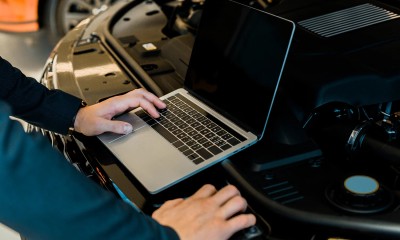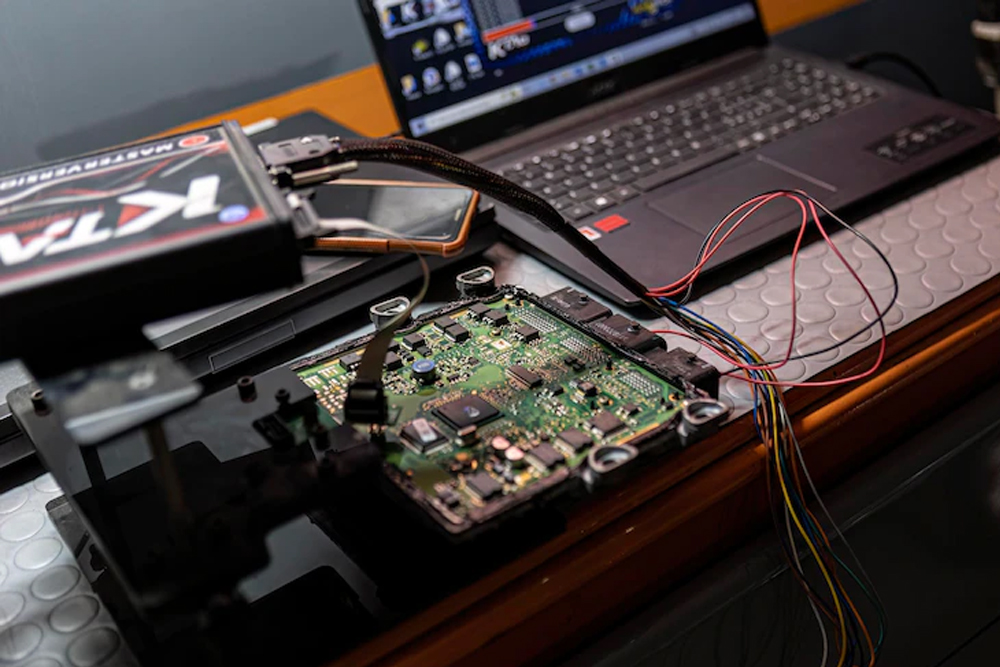ECU Programming vs. Reprogramming: The Definitive 2024 Technical Guide

At the heart of every modern vehicle lies a sophisticated computer known as the Engine Control Unit (ECU), or sometimes the Engine Control Module (ECM). This microprocessor acts as the engine's brain, meticulously managing a vast array of functions to ensure the vehicle operates smoothly, efficiently, and in compliance with environmental regulations. It constantly receives data from sensors throughout the engine—monitoring everything from oxygen levels and engine temperature to throttle position and crankshaft speed. Based on this data, it makes real-time adjustments to critical parameters like fuel injection volume, ignition timing, and, in turbocharged engines, boost pressure.
Vehicle manufacturers program these ECUs with a single, conservative set of parameters designed to perform reliably across the globe. This one-size-fits-all approach must account for a wide spectrum of variables, including diverse climate conditions, varying fuel quality, and stringent emissions standards in different markets. While this ensures reliability, it also means that nearly every vehicle leaves the factory with a significant amount of untapped performance potential. This is where the world of ECU modification begins. However, the terminology used in this field—programming, reprogramming, remapping, tuning—is often used interchangeably and incorrectly. This guide will provide a definitive technical clarification, empowering workshops, technicians, and enthusiasts with the precise knowledge needed to navigate this complex subject.
Demystifying the Terminology: Programming, Reprogramming, Remapping, and Tuning
Understanding the precise definitions of these terms is the first step toward professional competence. While they are related, they describe distinct processes with different applications and outcomes.
Defining the Core Concepts: A Clear Distinction
-
ECU Programming: This is the foundational process of installing, configuring, or updating the core operating software on an ECU. Think of it as installing a new operating system on a computer. This procedure is typically performed on a brand-new ("virgin") ECU, a replacement unit being fitted to a vehicle, or to recover an ECU with corrupted software. It is a restorative or enabling process that makes the ECU functional within a specific vehicle; it is not, by itself, a performance enhancement.
-
ECU Reprogramming (Remapping): This is the process of modifying the existing software parameters—often called "maps"—within a fully functional ECU to optimize its performance. This is the most common service associated with performance enhancement. A technician reads the original software from the ECU, alters specific data tables (maps) that control fuel, boost, and timing, and then writes the modified software back to the ECU. In the modern tuning industry, the terms "reprogramming" and "remapping" are functionally interchangeable.
-
ECU Tuning: This is the broadest, all-encompassing term for the practice of optimizing an engine's performance by modifying its control parameters. It includes reprogramming/remapping as its primary method but also encompasses the entire diagnostic and verification process. A true "tune" considers the vehicle's mechanical health, hardware modifications, and the analysis of data logs to ensure the result is both powerful and safe.
-
Chip Tuning: This is the historical predecessor to modern software remapping. On vehicles manufactured before the late 1990s, the ECU's maps were stored on a physical, removable memory chip (ROM). "Chipping" involved physically desoldering this chip from the ECU's circuit board, reprogramming it with new data in an external device, and then soldering it back into place, or replacing it with a new, pre-tuned chip. This highly invasive method is now obsolete for modern vehicles, which use reprogrammable flash memory.
The evolution from physical "chip tuning" to software-based "remapping" is a direct reflection of the technological leap in automotive electronics. The transition from hardware modification to software manipulation has not only made the process safer and fully reversible but has also enabled a level of precision and customization that was previously impossible. This fundamental shift is what created the modern B2B file service industry, allowing experts to develop, test, and digitally distribute high-quality tuning files to workshops worldwide—a business model unfeasible in the era of physical chip swapping.
Table 1: Terminology Comparison Matrix
For a clear, at-a-glance summary, this table contrasts the key characteristics of each term.
|
Feature |
ECU Programming |
ECU Reprogramming (Remapping) |
Chip Tuning |
|
Method |
Foundational software installation/configuration. |
Software modification of existing maps via OBD/Bench/Boot. |
Physical replacement or modification of an ECU's memory chip. |
|
Application |
New/replacement ECUs, fixing software corruption. |
Performance enhancement, fuel economy, custom setups. |
Performance enhancement on older (pre-2000) vehicles. |
|
Reversibility |
N/A (Initial setup) |
Fully reversible to factory original file. |
Difficult/permanent; requires physical chip swap. |
|
Invasiveness |
Software-based, requires specialized knowledge. |
Minimally invasive (OBD) to moderately invasive (Bench/Boot). |
Highly invasive; requires opening the ECU and soldering. |
The Two Core Processes: A Step-by-Step Technical Breakdown
A professional workshop must master two distinct ECU-related processes. The first is the foundational programming required to install a new unit, which is fundamentally a repair and restoration service. The second is the performance reprogramming that enhances a vehicle, which is an optimization service. Proficiency in both distinguishes a comprehensive ECU specialist from a simple tuner and opens up broader revenue streams from both the repair and performance markets.
Process A: Initial ECU Programming (Installation & Configuration)
When an ECU fails or needs to be replaced, simply swapping the hardware is not enough. The new unit must be programmed to integrate with the vehicle's specific electronic ecosystem.
-
Step 1: Physical Installation & Connection The process begins with basic mechanical work. First, the vehicle's battery must be disconnected to prevent electrical damage. The technician then locates the ECU, which can be in the engine bay, under the dashboard, or beneath a seat, and carefully removes any covers or panels to access it. The old unit is unbolted, its wiring harnesses are disconnected, and it is swapped with the new one. All connectors must be securely reattached to the new ECU.
-
Step 2: VIN (Vehicle Identification Number) Writing The Vehicle Identification Number (VIN) is a unique 17-digit code that acts as the car's fingerprint. The ECU, along with other critical modules, must have the correct VIN stored in its memory to communicate properly with the rest of the vehicle's network and to be recognized by diagnostic tools. Using a professional diagnostic scanner or programming tool connected to the OBD-II port, the technician writes the vehicle's VIN into the new ECU's memory.
-
Step 3: Immobilizer Synchronization & Key Pairing This is a critical security step. The ECU, the immobilizer module, and the transponder chip in the vehicle's keys all contain security codes that must be synchronized. If these codes do not match, the immobilizer system will prevent the engine from starting as an anti-theft measure. The "syncing" or "relearning" process introduces the new ECU to the vehicle's security system, authorizing it to operate. This often requires a special security PIN, which may need to be obtained from an authorized dealer with proof of ownership.
-
Step 4: Module Coding and Adaptation The final step is to code the ECU with the specific configuration of the vehicle. This involves setting parameters for features like the type of transmission (automatic or manual), cruise control, and other vehicle-specific options. After coding, sensor adaptations are often reset. This clears old learned values and allows the new ECU to calibrate itself to the precise readings of the sensors in its new environment, ensuring optimal operation.
Process B: ECU Reprogramming for Performance (Remapping)
This is the process of modifying a functioning ECU to unlock better performance. It is a delicate procedure that demands a methodical approach.
-
Step 1: Vehicle Health Check and Initial Diagnostics A professional tune always begins with a thorough assessment of the vehicle's health. A full diagnostic scan is performed to ensure there are no pre-existing Diagnostic Trouble Codes (DTCs). Key systems like the fuel pump, injectors, ignition system, and turbocharger are checked to confirm they are in good working order. Attempting to tune a vehicle with underlying mechanical issues is a recipe for failure and can lead to engine damage.
-
Step 2: Reading the Original ECU File (OBD, Bench, Boot Modes) To modify the software, the original factory file must first be extracted from the ECU. There are three primary methods for this:
-
OBD (On-Board Diagnostics): This is the most common and least invasive method. A tuning tool is connected to the vehicle's OBD-II port (usually under the dashboard) to read the software directly.
-
Bench Mode: For some ECUs, particularly those with anti-tuning protection, reading via the OBD port is not possible. In Bench mode, the ECU is removed from the vehicle and connected to the tuning tool on a workbench using special probes that connect directly to the ECU's pins, without needing to open the unit's casing.
-
Boot Mode: This is the most invasive method, reserved for ECUs that cannot be read by OBD or Bench. It requires carefully opening the ECU's housing and connecting directly to specific points on the circuit board to force the microprocessor into a "boot" state, allowing the memory to be read.
-
-
Step 3: Modifying the Map Parameters (The Art of Tuning) The original file is then loaded into specialized file editing software. Here, the tuner analyzes the data and modifies hundreds of interconnected maps. Key adjustments include altering fuel injection quantity, optimizing ignition timing advance, increasing turbocharger boost pressure targets, adjusting torque limiters to allow for more power, and refining throttle maps for better response. This is a highly skilled task that requires a deep understanding of engine dynamics.
-
Step 4: Writing the Modified File to the ECU Once the modifications are complete, the new, tuned file is written—or "flashed"—back onto the ECU's memory using the same method (OBD, Bench, or Boot) that was used for reading. This is a critical phase where a stable power supply is non-negotiable. A dedicated battery maintainer must be connected to the vehicle to ensure voltage does not drop during the writing process, as an interruption can corrupt the ECU, rendering it unusable (a state known as "bricking").
-
Step 5: Verification, Data Logging, and Fine-Tuning The job is not finished after the flash. The technician must first clear any DTCs that may have been generated during the programming sequence. The vehicle is then started, and a crucial process known as data logging is performed. This involves recording the engine's real-time operating parameters during a test drive or on a dynamometer to verify that the changes are performing as intended and that all vital signs—like air-fuel ratios and boost levels—are within safe limits.
The Professional's Toolkit: Hardware, Software, and Industry Standards
Professional ECU tuning requires a significant investment in specialized tools and software. The quality of this equipment directly impacts the safety, reliability, and effectiveness of the work performed.
The J2534 Pass-Thru Standard: Enabling Universal Communication
The modern independent auto repair and tuning industry owes much of its capability to the SAE J2534 standard. Mandated by the U.S. Environmental Protection Agency (EPA) for all 2004 and newer vehicles, this standard created a universal Application Programming Interface (API) for ECU reprogramming. It allows a single, standardized piece of hardware, known as a "Pass-Thru" device, to act as a bridge between a technician's computer and the vehicle's ECU. This broke the manufacturers' monopoly on expensive, proprietary dealer tools and enabled the aftermarket to perform factory-level programming and diagnostics. The standard is split into J2534-1, which covers emissions-related modules like the engine and transmission, and the optional J2534-2, which extends compatibility to other non-emissions modules.
Essential Hardware for Reading & Writing
-
Deep Dive: Alientech KESS3 - The All-in-One Solution A leading tool in the industry is the Alientech KESS3. It represents a significant evolution in tuning hardware by combining the functions of older tools into a single, powerful unit. Its key advantage is its ability to perform OBD, Bench, and Boot programming with one device, streamlining the workshop's workflow. It features a processor that is vastly more powerful than previous generations, automatically recognizes the correct communication protocol to use, and is built into a rugged, durable casing, making it a reliable choice for professional environments.
-
Master vs. Slave Tools: A Critical Business Decision Professional tuning tools like the KESS3 are available in two versions: Master and Slave. The difference is fundamental to the structure of the tuning industry.
-
Master Tool: A Master tool can read the original file from an ECU, and the user has the ability to open and edit that file using separate software. It offers complete autonomy to the tuner who develops their own files.
-
Slave Tool: A Slave tool is cryptographically linked to a specific Master tool. It can read the original file from an ECU, but the file it creates is encrypted and can only be opened by its designated Master. The workshop sends this encrypted file to their Master file provider (like HP Chiptuningfiles), who then modifies it and sends back an encrypted tuned file. The Slave tool can then write this tuned file to the vehicle, but the workshop owner can never open or edit the file themselves.
-
This Master/Slave ecosystem is not merely a tiered product offering; it is a sophisticated B2B supply chain designed to securely distribute high-value intellectual property—the tuning file. The Slave tool acts as a secure terminal, allowing a workshop to deliver an expertly engineered product without needing the years of experience, expensive R&D, and immense liability associated with file development. For the Master provider, it ensures quality control and protects their dyno-developed files from being copied or poorly modified.
Essential Software for File Editing
-
The Industry Standard: EVC WinOLS For tuners operating Master tools, EVC WinOLS is the gold-standard software for editing ECU files. It is a powerful hex editor designed specifically to help a tuner navigate the raw binary data read from an ECU. It uses checksums and map packs to help identify, visualize (in 2D, 3D, and text formats), and modify the thousands of parameters that control engine behavior.
Unlocking Potential: The Benefits and Stages of ECU Tuning
A professional ECU remap offers a holistic improvement in a vehicle's performance and characteristics.
Primary Benefits: A Holistic Improvement
-
Increased Power (HP) and Torque (Nm): This is the most common goal. By optimizing the engine's maps, tuners can safely unlock significant gains in horsepower and torque, resulting in faster acceleration and a more powerful feel.
-
Improved Fuel Efficiency: Especially in turbocharged diesel engines, a remap can lead to better fuel economy. By increasing torque at lower RPMs, the engine can operate more efficiently, allowing the driver to use higher gears sooner and reduce fuel consumption during normal driving.
-
Enhanced Throttle Response and Drivability: A quality tune can eliminate throttle lag and create a much more responsive and engaging driving experience. Power delivery becomes smoother and more linear, making the car feel more refined.
-
Removing Factory Limiters: For motorsport applications, tuners can safely adjust or remove conservative speed limiters and increase the engine's rev limit, allowing the vehicle to reach its true top speed on a track.
Table 2: Understanding Tuning Stages
The term "Stage" is widely used in the tuning world to signify the level of modification. It's crucial to understand that software stages are directly tied to required hardware upgrades.
|
Tuning Stage |
Software Adjustments |
Required Hardware Modifications |
Expected Outcome |
|
Stage 1 |
Optimized for a mechanically standard vehicle. Adjusts fuel, boost, timing, and limiters. |
None required. A performance air filter is optional but complementary. |
Significant, reliable power/torque gains. Improved economy and drivability. |
|
Stage 2 |
Calibrated to account for increased airflow and reduced exhaust backpressure. More aggressive targets. |
High-flow downpipe (sports cat or de-cat), larger intercooler, performance intake system. |
Further increase in power/torque. Sharper response. Requires hardware for safety. |
|
Stage 3 |
Custom calibration for major hardware changes. Requires dyno tuning and data logging. |
Upgraded turbocharger, upgraded fuel injectors/pump, potentially internal engine work. |
Maximum possible performance from the platform. A bespoke, custom solution. |
Navigating the Risks: Why Quality Tuning Files Are Non-Negotiable
While professional tuning is safe and effective, the market is flooded with low-quality, generic files that can cause serious and expensive damage. Choosing a reputable file provider is the single most important decision a workshop can make.
The Dangers of Low-Quality or Generic Remaps
Cheap, untested, "copy-paste" files from amateur tuners or unreliable online sources pose a significant threat to a vehicle's health. These files are often created without proper vehicle-specific development or testing.
Common Symptoms of a Bad Remap
-
Check Engine Lights (MIL) and Persistent Fault Codes: A properly calibrated remap should not trigger warning lights. If the check engine light appears after a tune, it indicates that the software is incompatible or is pushing parameters beyond the ECU's safety limits.
-
Excessive Black/Grey Smoke: This is a clear visual indicator of an incorrect air-to-fuel ratio (AFR), typically from over-fueling. It can quickly clog Diesel Particulate Filters (DPFs), cause the vehicle to fail emissions tests, and lead to long-term injector damage.
-
Poor Drivability: Instead of smooth power, a bad remap can cause a rough idle, hesitation during acceleration, unpredictable power surges, or the vehicle suddenly entering "limp mode" as the ECU's protective strategies engage to prevent catastrophic failure.
-
Accelerated Component Wear: Poorly calibrated maps can destroy mechanical components. A torque curve that is too aggressive at low RPMs can cause the clutch to slip and wear out prematurely. Consistently excessive boost pressure will drastically shorten the life of a turbocharger.
Table 3: Professional vs. Amateur Tuning Outcomes
This table serves as a powerful tool for workshops to educate their customers on the value of quality, shifting the conversation from price to safety and reliability.
|
Feature |
Professional Service (HP Chiptuningfiles) |
Amateur / Low-Quality Service |
|
File Origin |
Custom developed, dyno-tested, and data-logged for the specific ECU/engine. |
Generic, "off-the-shelf" file, often a copy of unknown origin. |
|
Process |
Includes pre-tuning diagnostics and post-tuning verification. |
No diagnostics; "flash and go" approach. |
|
Safety |
Calibrated within the safe mechanical limits of the engine and drivetrain components. |
Ignores torque limiters, pushes boost beyond safe levels. |
|
Outcome |
Smooth, reliable power delivery. Maintained or improved fuel economy. |
Power spikes, poor drivability, increased wear, potential engine damage. |
|
Support |
Professional technical support for the workshop. |
No support, vague guarantees. |
Warranty, Legal, and Insurance Implications
It is crucial to be transparent about the consequences of ECU modification. Any alteration to the ECU's software can be detected by dealership diagnostic tools and will almost certainly void the vehicle's powertrain warranty. Furthermore, vehicle modifications should be declared to insurance providers, as failure to do so can invalidate the policy in the event of a claim. Finally, it is illegal in many regions, including the UK and EU, to modify or remove emissions control systems like the DPF or EGR on road-going vehicles.
The Science of Precision: The Critical Role of Data Logging
If the ECU is the engine's brain, data logging is its vital signs monitor. It is the empirical, evidence-based process that separates professional engineering from dangerous guesswork. Tuning an engine without data logging is akin to a surgeon operating blindfolded; the risks are unacceptably high.
What is Data Logging and Why is it Essential?
Data logging is the process of using diagnostic software to record a live feed of engine parameters directly from the ECU's sensors while the engine is running under load. This raw data provides a precise, real-time window into how the engine is actually responding to the changes made in the tune. It is the critical feedback loop that allows a tuner to verify that performance is optimized without compromising safety. A file provider that bases its products on extensive data logging and dynamometer testing is not just selling software; they are selling a scientifically validated and engineered solution.
Key Parameters to Monitor for Safe & Effective Tuning
A professional tuner analyzes a wide range of parameters from a data log to confirm the quality and safety of a tune:
-
Air-Fuel Ratio (AFR): Monitored via wideband oxygen sensors, this is arguably the most critical parameter. A lean mixture (too much air) can cause dangerously high combustion temperatures, leading to detonation and catastrophic engine failure. A rich mixture (too much fuel) wastes fuel, reduces power, and can damage catalytic converters and DPFs.
-
Boost Pressure vs. Target Boost: The log shows if the turbocharger is delivering the amount of boost requested by the tune. If actual boost is significantly lower than target, it could indicate a boost leak. If it's much higher, it points to a dangerous overboost condition.
-
Ignition Timing & Knock Retard: Optimal ignition timing advances the spark for maximum power. However, too much advance can cause detonation (knock), a violent, uncontrolled explosion in the cylinder that can destroy pistons. The ECU's knock sensors detect this and "retard" (pull back) the timing to protect the engine. A data log showing consistent knock retard is a clear sign that the tune is too aggressive.
-
Exhaust Gas Temperature (EGT): EGT is a direct indicator of thermal stress on the engine, exhaust valves, and turbocharger. A quality tune keeps EGTs within safe operational limits.
This data-driven, iterative process—flash, log, analyze, refine—is the hallmark of a professional tuning file developer and is essential for creating powerful, reliable, and safe ECU calibrations.
The HP Chiptuningfiles Advantage: Your Partner in Professional Tuning
Navigating the complexities of ECU programming and reprogramming requires a partner dedicated to quality, safety, and support. HP Chiptuningfiles is Europe's leading provider of custom, dyno-tested tuning files, built on a foundation of engineering excellence.
Our Commitment to Quality: Custom, Dyno-Tested Files
Our entire business is built on the principles outlined in this guide. We reject the "one-size-fits-all" approach. Every tuning file we develop is created in-house on our state-of-the-art dynamometer. We use extensive data logging to meticulously calibrate each file, ensuring it delivers optimal performance while operating safely within the mechanical limits of the vehicle. This commitment to empirical testing and validation is our guarantee of quality.
Comprehensive Support for Our Global Network of 4,000+ Clients
We are a B2B-focused company, dedicated to the success of the professional workshops we serve. Our clients gain access not only to our premium files but also to our team of expert technical support staff. Whether you need assistance with a specific vehicle, advice on diagnostics, or help interpreting data, our team is here to support your business.
Streamlining Your Workflow: Our B2B Portal and File Service
Our online portal is designed for efficiency. It provides a seamless interface for our clients to upload original vehicle files and receive professionally tuned files quickly, allowing you to serve your customers with minimal downtime.
-
Ready to experience the difference that professionally engineered tuning files can make to your business? Create your free account today to explore our extensive tuning file database and see why over 4,000 professionals trust HP Chiptuningfiles.
-
Have questions about our services or need advice on a specific vehicle? Contact our expert support team—we're here to help you succeed.
-
Looking to equip your workshop with the best tools in the industry? Browse our selection of professional tuning hardware.
Frequently Asked Questions (FAQ)
-
Q1: Can ECU reprogramming be reversed? A: Yes. A key advantage of modern ECU reprogramming is that it is completely reversible. A professional tuner always saves your vehicle's original factory file and can flash it back to the ECU at any time, restoring it to its standard state.
-
Q2: How do I know if my car has already been remapped? A: It's often impossible to tell from a simple diagnostic scan. The most reliable way is to have a professional tuner read the file from your ECU and compare its data (checksums and map values) against a known original file for your vehicle's specific software version. Sometimes, a dyno test revealing performance significantly above stock levels is also a strong indicator.
-
Q3: Will reprogramming damage my engine or void my warranty? A: A professional remap from a reputable source like HP Chiptuningfiles is designed to operate within the safe mechanical tolerances of your engine. However, low-quality, overly aggressive remaps can cause significant damage. Any modification to the ECU can be detected by dealers and will likely void the powertrain portion of your manufacturer's warranty.
Q4: What is the difference between a remap and a tuning box? A: A remap directly modifies the core software inside the ECU for precise control over all engine parameters. A tuning box (or piggyback module) is an external hardware device that intercepts signals from sensors (e.g., fuel pressure, boost pressure) and sends modified signals to the ECU, tricking it into making changes. Remapping is a more sophisticated, integrated, and generally safer method of tuning.
Other news and updates

Read more OBD Breakthrough: Tuning Support for the Continental ASG1 ECU in Audi e-tron & Porsche Taycan
The Continental ASG1 ECU used in the Audi e-tron and Porsche Taycan is now fully supported for OBD read/write. This breakthrough allows safe tuning of torque limits, current maps, thermal strategies and pedal response, enabling measurable performance gains whi...
Read more

Read more Stage 1, Stage 2, and Stage 3 Tuning: Which One Is Right for You? | HP Chiptuning Files Europe & UK
Discover the differences between Stage 1, Stage 2, and Stage 3 tuning. Learn which remap is best for your car, driving style, and budget at hp-chiptuningfiles.com.
Read more

Read more Mercedes-AMG G63 2025: ECU Remap & Performance Boost
Hey, we are HP Chiptuningfiles – Europe’s leading ECU tuning file service provider. We deliver custom, dyno-tested tuning files for diesel, petrol & hybrid engines, trusted by 4,000+ clients worldwide. The 2025 Mercedes-AMG G63 combines iconic G-Class ruggedne...
Read more